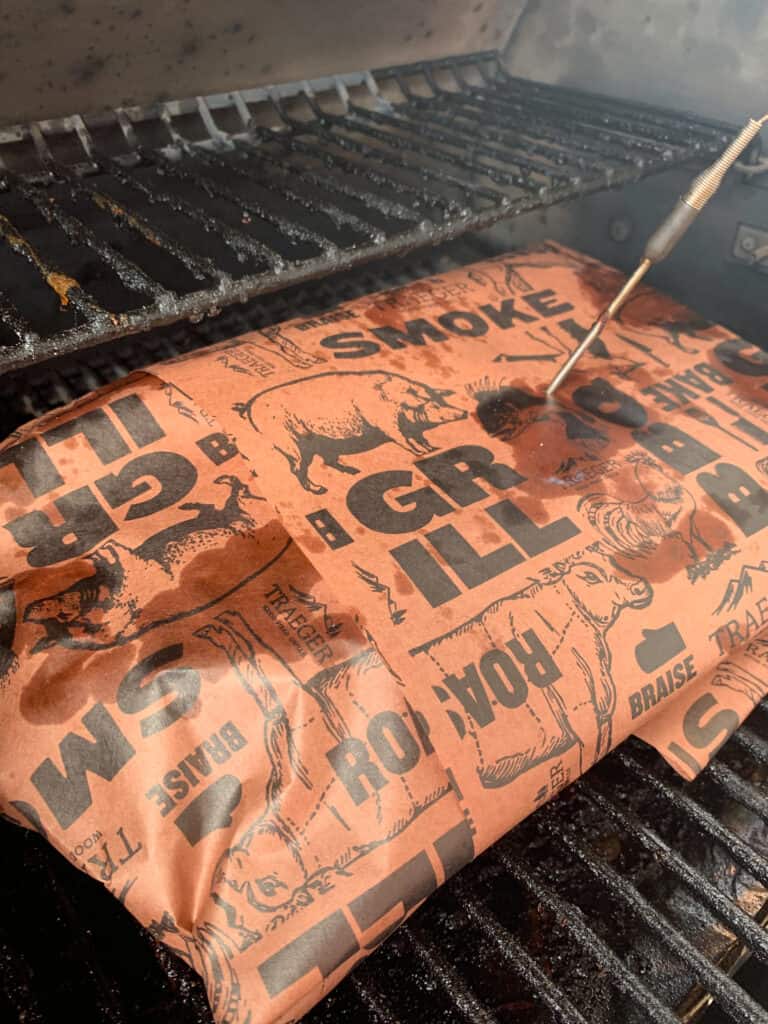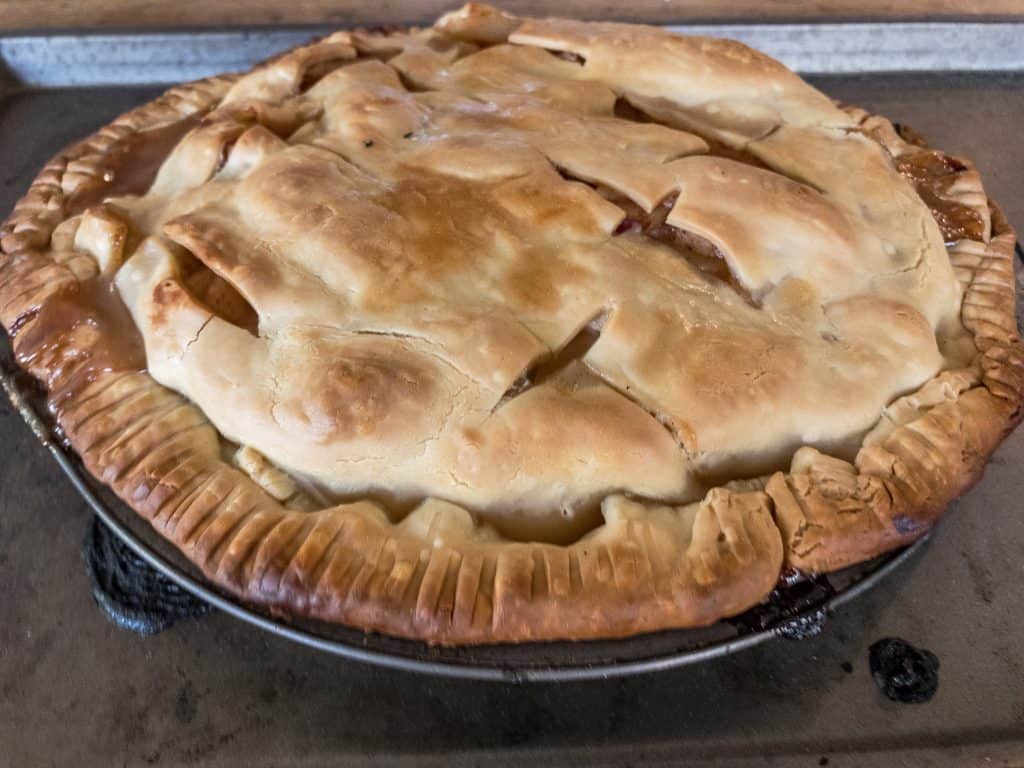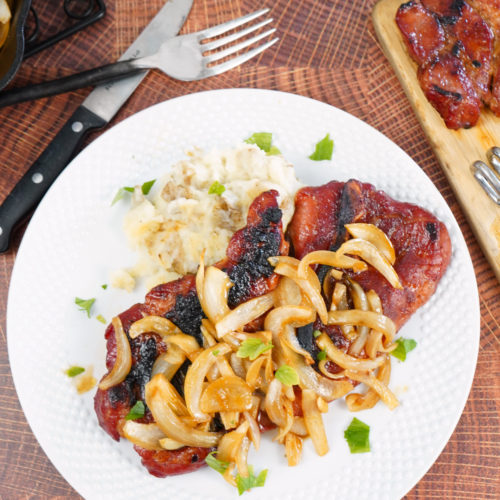Table of Contents
A Smoked Brisket Recipe That Produces Outstanding Results
When I first started smoking meat, I was intimidated by big cuts of meat like Brisket or pork shoulders. If you've never cooked a big cut of meat before, it can be tough to know what to do, and how to make sure you don't waste a whole bunch of time and money, only to have what tastes like shoe leather come off the smoker when you're done. If you're looking for a smoked brisket recipe, you've come to the right place.

How to Choose a Brisket
There are a few things you should keep in mind when you're at the butcher shop or grocery store selecting your brisket.
- Know what you're looking for. I like smoking a whole brisket, also called a "packer". Packer briskets can range in weight from 10-15+ pounds and can feed a crowd of people. A whole brisket actually consists of two separate muscles, that have distinctly different feel once they've been cooked. You'll hear these two muscles mentioned as the "point" and the "flat". The point has a higher fat content and is often chunked up to use for burnt ends. The flat is a little leaner, but still equally delicious.
- There are different grades of meat available for brisket, and I'd recommend choosing at least "choice" grade. If you can swing it, prime is better. The grades are based on the marbling of the meat. The higher the grade, the more marbling, which will greatly benefit the final outcome of the cook. You can still make a select grade brisket taste great, but it's been my experience that it requires a little bit of extra love to keep a select grade brisket moist and tender when cooking low and slow.
If I'm cooking a special meal I'll order a wagyu brisket. Wagyu briskets are the best I've seen but prime can be a better bang for your buck on a regular basis
A Smoked Brisket Recipe for Beginners
I understand that cooking brisket on a smoker can be overwhelming, especially if you've never cooked one before. That's why I've taken the time to go into detail and share with you exactly how I cook my briskets. In this post you'll learn:
- How to trim a brisket
- Which rub to apply to a brisket
- How to smoke a brisket
- Overcoming the stall
- How to slice a smoked brisket
- Sides to serve with smoked bbq brisket
- Desserts to serve with smoked brisket
After reading, if you feel like I've missed something, leave me a note in the comments. I am happy to answer any questions you may have about how to smoke a brisket. If you're new to smoking meat, also consider checking out my post about Smoking Meat for Beginners.

How to Smoke a Brisket
Smoked Brisket Recipe Prep Work
You may have some extra large fat deposits on one end of the wagyu brisket. This portion of the brisket will also be much thicker than the rest of the cut. This large area of fat separates what is called the point, and the flat of the brisket that we mentioned earlier.
How to Trim a Brisket
You'll want to trim most of the larger fat deposits off of the meat. Leave at least a quarter-inch of fat on the meat. You want to keep some fat on the Brisket to help moisten the meat during the cook. My rule of thumb is that if the fat is hard, remove as much as you can without affecting the meat. If it's soft, leave it!
I've done a few cooks where I've even removed all of the fat on both sides just to see how it impacted the final result. With a Wagyu or prime grade, this works, but I wouldn't do that with choice grade or lower.
Smoked Brisket Rub Recipe
After you've trimmed the fat, rub the entire surface with about 2 tbsp of Olive Oil. I like to use garlic-infused olive oil for a little extra flavor, but you don't have to. The olive oil acts as a binder to hold the rub on the brisket. Other binder options include avocado oil, mustard, or hot sauce (not for the weak!)
I sell a couple of different rub recipes here on the site that I really love, and have consistently produced a great bark. You can purchase my bbq rub recipes here. I like making my own rub because it allows me to have a really solid base flavor profile that can be modified with additional spices to enhance it.
If you want to buy a rub that's been premade I'd recommend one of the rubs from WhiskeyBent BBQ or Meat Church.
Once you have your rub, make sure you apply it liberally. 1 Tbsp of bbq rub isn't going to adequately season a large hunk of meat like this! It's really hard to over season a piece of meat like this, so go big!

Smoking a Brisket - Wood Selection and Temp
Set up your smoker to smoke at 225 degrees using indirect heat. I like to use oak for this recipe, but mesquite can give you some really bold smoky flavor too. Once your smoker is up to temp, place the brisket on the smoker, fat cap down.
FYI, I estimate 90 minutes for every pound at 225 degrees, so you could be looking at 15 hours or more for this cook.
After 4 hours put a temperature probe into the center of the thickest part of the flat. Monitoring the temperature remotely using a Thermoworks smoke, or your smoker's app is best - the less you open the lid on your smoker the better.
The built-in temperature probes are great for keeping track of what the internal temperature is but I don't recommend using those to find out if your meat is finished. It's been my experience that those probes are off by 5-10 degrees. I use a Thermoworks Smoke to keep track of internal temps during the cook, and then spot check with my Thermapen ONE.
A Thermapen ONE is hands down the best internal temperature probe you can buy. It's calibrated for 99.9% accuracy, and it's what I rely on when I am cooking for friends and family to make sure my meats come out at the perfect temperature every time.
If there is one tool I rely on more than my smoker, it's a Thermapen.
When the temperature gets up to 160-165 degrees you'll experience a "stall" where the temp doesn't go up at all. The stall could last hours. Don't panic! The stall is normal. Do not panic and increase the temperature of your smoker. Just be patient. It will be ok.
Minimize the Length of the Stall
Once your brisket is at the 160-165 degree point, peek on the meat every 40 minutes or so. When the surface of the meat has a dark mahogany "bark" pull the brisket off the smoker, and wrap it tightly with pink butcher paper.
After the brisket is wrapped, put back in the smoker. Push your temperature probe through the wrap into the meat, and check the temperature every hour until the internal temperature gets to 200 degrees. This wrapping technique is called the "Texas Crutch".

The Texas Crutch is a great method to help push through the stall and retain more moisture in your meat. In some instances, you could lose some bark quality.
If you'd prefer to not wrap that's fine, just plan on a longer cook. If I'm not going to wrap my brisket I will put it on the smoker at 9 or 10 pm the night before. Whether you crutch or not, is up to you.
When the brisket hits 200 degrees, pull it from your smoker. Wrap over the butcher paper with foil, and put it in a cooler with a towel or two on top of it, and close the lid. Let it rest in the cooler for at least 60 minutes. I let them rest for a minimum of two hours. This helps the moisture in the meat redistribute and results in more flavor in every slice of brisket.
Resting a Smoked Brisket
Start smoking meat early in the day. It's ok to start at 4 or 5 am and then go back to bed. If it finishes two or three hours before you are ready to eat, that's ok. I've held briskets in a cooler for up to 5 hours. The longer they rest, the better the juices distribute. Just be sure to not let the internal temperature of the meat get down below 150.

When you're ready to serve, slice against the grain of the meat, in pencil-thin slices. The flat will have a grain running in one direction, and the section of meat on top (the point) will have the grain running in a different direction.

I separate the point and flat when it is time to serve, and then cut each of them individually. Alternatively, you can turn the point into bbq brisket burnt ends.
Sides for Smoked Brisket
No barbecue Traeger brisket meal is complete without some good sides. My first choice is a delicious salad. One of my favorites is a good wedge salad.
Second, you need some good cornbread. If you have the time, make it on your pellet smoker! No need to go overboard here, just buy a packet of cornbread mix at the store and follow the instructions. Serve it warm with butter.
Last but not least, serve up some barbecue baked beans, or if you really want to get fancy, three-bean casserole!
This is a feast your whole family will love. Heck, you'll have enough brisket to feed the neighbors, so you should probably invite them over too!

I hope you're hungry! A whole smoked brisket can serve a ton of people!
And oh by the way... this brisket is awesome with a sauce, but if you're looking for a great bbq sauce, my sweet and spicy bbq sauce recipe is fantastic.
Dessert
Wait, wait, wait! We need dessert too! You are cooking a gourmet feast with smoked coffee brisket and your guests deserve dessert before you roll them out the front door!
I've made quite a few different desserts on my smoker, here are a few of my favorites:
- Apple Pie
- Smoked Oreo Cheesecake
- Smoked Peach Cobbler
- Smoked Pineapple Upside Down Cake
- Smoked Huckleberry or Blueberry Cobbler

Step by step details for the smoked brisket recipe can be found below. I am so glad you took the time to read this post and learn more about how to smoke a brisket.
Have you cooked a brisket recently? How did it turn out? What kind of challenges do you face when you smoke brisket? Let's talk about it in the comments!
If you're looking for another great brisket recipe, check out my guide to prepare corned beef brisket.
Smoked Brisket
Equipment
Ingredients
- 12 lbs Whole Brisket
- 2 tbsp Olive Oil Garlic Infused
- 4 Tbsp of BBQ rub
Instructions
- Remove your brisket from the fridge, and trim the fat off the brisket as much as possible, leaving a layer of about ¼". Take care to not over trim the brisket where the point and flat come together.
- Once the brisket is trimmed, get smoker setup to smoke at 225 degrees using indirect heat
- Rub the entire brisket with the Garlic Infused Olive Oil or your preferred binding agent.
- After applying the binder to the brisket, generously apply the rub to the entire surface of the meat.
- By this time your smoker should be up to temp. Place the brisket directly on the grill grates fat cap down. If you got up early to start this cook, now is a good time to take a nap.
- After 4 hours check your smoker and the temp on your meat. When I cook a whole brisket I place a separate probe in the point and the flat. Those two pieces of meat will cook at different speeds, and it's good to know where each of them sits.
- The magic number you're waiting for right now is 160 degrees. Some people like to go for "look", or "feel" when they are cooking a brisket, but I'm not willing to leave it up to chance when I'm dealing with a piece of meat like this.
- At 160, wrap the brisket tight in pink butcher paper, and then return to the smoker.
- After wrapping, check the temp on your probes every hour. Once your temp is up to 200, it's time to pull the brisket from the smoker.
- DON'T unwrap the brisket, it's not done! Wrap over the butcher paper with foil, and place the brisket in a sealed cooler, with towels, and let it rest for at least two hours.
- Once the brisket has adequately rested, pull it from your cooler, set the table, and then slice it up! Don't forget, ALWAYS slice your brisket against the grain of the meat. This will ensure that every bite melts in your mouth.







I never thought of mustard. What type do you use? Dry powder? Wet, yellow, spicy brown, large grain? I have been smoking beef and pork for many yrs and my favorite wood to use is mesqite for beef and apple for PORK. Sometimes I make the dry rub from scratch but more often I buy Adam's rub and add a bit of oregano and creole seasoning. I finsh it with Jack Daniels GLAZE. Not to be mistaken for Jack Daniels barbeque sauce. The glaze can only be bought from TGI FRIDAYS in half gallon bags but its unbelievable.
Hi James, I'll have to check out that JD Glaze at TGI Fridays. It sounds fantastic! When I use mustard for my binding agent I just use yellow. Recently I've started using garlic infused olive oil and it seems to have a similar effect. Totally agree with your wood choices!
Hello, just wondering with option 1, do you also have to cover and rest in cooler before slicing or is that only for option 2?
You'll want to cover and let rest with either option.
Sorry one more question, is the temperature in celcius or Fahrenheit?
No worries! Temp is in Fahrenheit.
Do you spritz your briskets? If so starting when, and how often? Also do you put a water pan in the Treager with your brisket?
Awesome website, that's for all the info!!
Hi Brandon! I don't usually spritz or use a water pan. If I'm cooking a choice grade or lower brisket I will inject it with beef broth to help keep it moist.
I think the big key here is to make sure you keep the lid closed. Every time you open you are letting heat out, along with a ton of moisture.
After you wrap the brisket in paper and are waiting for the internal temp to reach 200F. Do you put the probe into the flat or the point? I saw you said check the flat for the 160-165 limit before you wrap but wasn’t sure if it was the same for finishing it off at 200F.
Once you wrap the brisket, approximately how long do you cook it for?
Hi. I have a sm smoker electric. I found a brisket around 5 lbs choise. Anyway we are a family of 3 so i already know this is way to much meat for us . After i smoke it can i cut n freeze to family size . Have you ever tried that if so did it taste about the same. I canned the rest of my pulled pork . Yes im a newbie
What adjustments would you make for buffalo brisket?
What if you forgot the binding agent and already put your rub on it? Lol